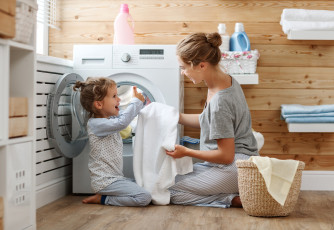
Environment
Shared activities during daily routine: another way how a child learns
Sometimes adults do not realize that just playing with children might be something more. Through the easiest activities, a child’s development happens. What does a child learn in the kitchen, the living room, while getting dressed or blowing bubbles?
Activities in the kitchen
Motor skills
Stir, cut and chop to develop muscle strength
Add spices, create little balls and decorate – developing small motor skills
Language
Listen to and read recipes and fulfill the instructions
Learn the names of the foods and tools in the kitchen
Describe the tastes, shapes, textures, temperatures, etc., of the food
Cognitive skills
Learn about table manners
Count how many dishes are needed, measure and weigh products, separate products in parts
Add what is needed to be added together (a kettle with its cover, separate spoons, knives, and forks, put together the bowls or plates that are the same)
Digital tools
Motor skills
Dance to the music or recreate the dance moves seen on the screen
Small motor skills – use buttons or switches (on whichever digital tool)
For the development of coordination between sight and hands, there are multiple games on tables and/or smartphones
Language
Talk about what they see and hear on a device
Read together e-books or listen to audiobooks (and also discuss the plot)
Communicate with friends and relatives
Cognitive skills
The feeling of time (for example, when there is limited time for using a device)
An understanding between correlation and causation (if I press a button, something will happen)
Physical activities indoors and outdoors
Motor skills
Exercises for strengthening muscles
Movement in fresh air
Movement of cleaning the house or tidying toys
Movement while playing games
Games with a ball
Language
Learn about verbs
Developing vocabulary by naming the tools used while exercising
Cognitive skills
Follow instructions
Count how many times an exercise has to be done
Washing clothes
Motor skills
Putting clothes in the washing machine
Taking the clothes out
Folding clothes
Language
Naming the pieces of clothing and needed materials for washing (for example, soap, softener or freshener)
Cognitive skills
Following instructions
Separating clothes based on their characteristics (dad’s clothes, white clothes, etc.)
Getting dressed
Motor skills
Coordination of movement (putting a leg in the right side of the pant, putting a hand in the sleeve of the shirt, etc.)
Putting on a piece of clothing correctly (right and left side, bottom and front)
Buttoning buttons, tying shoelaces, zipping up zippers
Language
Naming and describing clothes
Vocabulary – under, on, next to, together, couple, above, etc.
Cognitive skills
Understanding the right order (what to wear after what)
Understanding which clothing goes together (the same socks, mittens, similar clothing by color, etc.)
Blowing bubbles
Motor skills
Bursting bubbles and developing coordination between sight and movement of arms
Catching bubbles and developing coordination
Language
Motor skills of the mouth, especially lips
Breathing
Cognitive skills
Correlation causation (if I touch a bubble, it will burst; if I blow the bubble slowly, it will be big, etc.)
Relaxing in the living room
Motor skills
Developing the movement of a child by using elements of the couch (pillows, blankets, etc.) and creating forts
Language
Read books
Talk about the plot of movies or cartoons
Play word games
Cognitive skills
Play board games (wait for their turn, count, feeling of time in games, that are time-limited), a child learns how to recognize and deal with the feelings of loosing
Take into consideretaion!
All activities have to be done with parents or with their supervision.
The environment is important so that the child does not have to reach or be on their tiptoes.
Explain the instructions and rules.
Finish the task TOGETHER.
The consultant for this material: Madara Ungere, Ikšķile’s Centre for Health Development
Photo: Shutterstock.com

 Log In
Log In